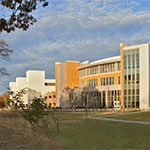Five years ago, the Commonwealth of Virginia issued an executive order that all new state construction and major renovations would be designed to LEED Silver standards. As a state agency, Northern Virginia Community College (NOVA) is following this executive order but also is committed to surpassing it.
NOVA has had a College Environmental Committee since 2007, which, as of 2012, is now supported by full-time sustainability coordinator Rob Johnson in order to not only reduce its carbon footprint, but also to increase education and awareness of sustainability and LEED.
As Virginia’s largest state-owned institution of higher education, NOVA administrators and faculty knew it was important to remain relevant and keep the college attractive to prospective students. “In many respects, we are leaders in the world of community colleges,” says Dan Wells, NOVA’s director of capital projects. “We need to be a leader in all fields, including sustainability.” With three buildings already LEED certified—one reaching Gold status—the college wanted to keep the momentum growing.

In addition to displaying its energy performance, NOVA offers classes on green building practices.
The 84,000-square-foot Arts and Sciences Building on the Woodbridge Campus is NOVA’s newest building. Completed in August 2013, the building includes a cafeteria, black-box theater, library, art labs, science labs, classrooms, and faculty offices. As one of just three campus buildings with geothermal wells, it is also expected to achieve LEED Gold certification.
The building also employs an energy dashboard by Lucid, a rainwater cistern, and two green roofs. On the top floor, the interior spaces, which are primarily windowless science labs, take advantage of solar tubes—a first for the institution. The entire building runs on a central, computerized light-control system.
To reinforce its function as an educational institution, the building has sustainability placards displayed throughout to explain features of the building to students and faculty. For those who want to go more in depth, the school also offers courses related to sustainability, including classes on efficient HVAC and geothermal systems. In fact, two miniature geothermal wells were installed in the labs specifically to serve as teaching tools for technicians and students.
The Arts and Sciences building has prompted NOVA to copy its success with the under-construction Workforce Development Center. The building, dedicated to NOVA’s community-oriented non-credit programming, is expected to open in mid-2015 and employs geothermal wells, light wells, and green roofs. Inside, a large meeting room with 1,200 to 1,500 seats can be subdivided to accommodate trade shows, corporate meetings, or large training events.
As a community college, NOVA’s tuition is roughly half that of a four-year state institution, but meager resources have not affected the college’s commitment to sustainability, seen in the six additional LEED projects it currently has in the works. “We’ve pushed sustainability beyond buildings,” Wells says. Already taking advantage of its geothermal wells, NOVA hopes to install wind generators, solar arrays, and other renewable energy sources—not only because they offer energy savings, but to make good on its environmental pledge.

